#Heilbronn (district)
Explore tagged Tumblr posts
Text

Gundelsheim, Baden-Württemberg.
71 notes
·
View notes
Text
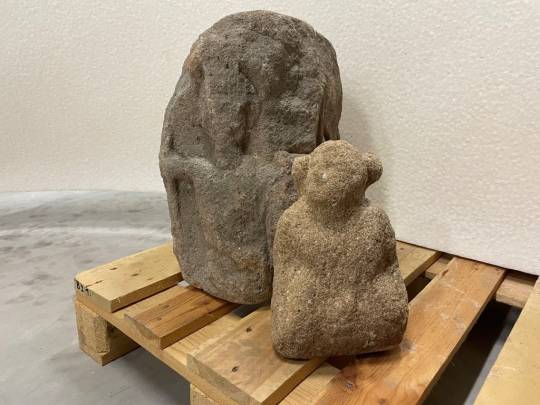
Stone Sculpture of a Roman ‘Giant’ Unearthed at Ancient Fort in Germany
The new find completes another artifact unearthed more than a century ago.
Due diligence in Stuttgart recently unearthed a stone sculpture that was actually part of an ancient Roman monument discovered at the same site more than a century ago. For the past few months, the State Office for Monument Preservation (LAD) has overseen excavations at a plot that had been tapped for the expansion of a local school. From 100 to 150 C.E., this very location hosted an ancient Roman fort, which became a larger settlement 100 years later. Those preliminary excavations paused, a release said, when an employee from the contractor ArchaeoBW spotted “a rather inconspicuous, mud-smeared sandstone.”
“The find turned out to be a 30 centimeter-tall kneeling figure with a human head,” the release says. “You can see how her arms rest on the sides of her upper body and her hands rest on her hips and legs.” It may take some imagination to fully grasp, but the chimera’s lower half shifts from a human torso to a serpent’s tail.
Fortunately, experts have ample historical context to understand the find. “The figure is a hybrid creature of the Roman-Germanic world of gods, a so-called ‘giant,’” said senior LAD archaeologist Andrea Thiel. Comparative analyses found that this figure hails from a larger Jupiter column—a type of religious monument that was particularly prevalent throughout Roman Germania during the 2nd and 3rd centuries.
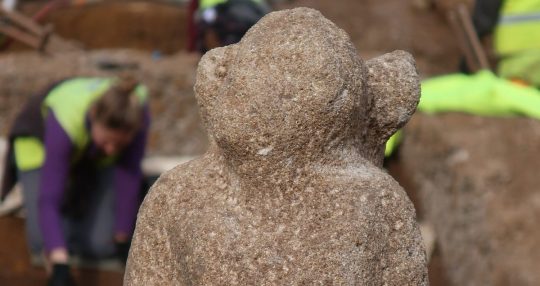

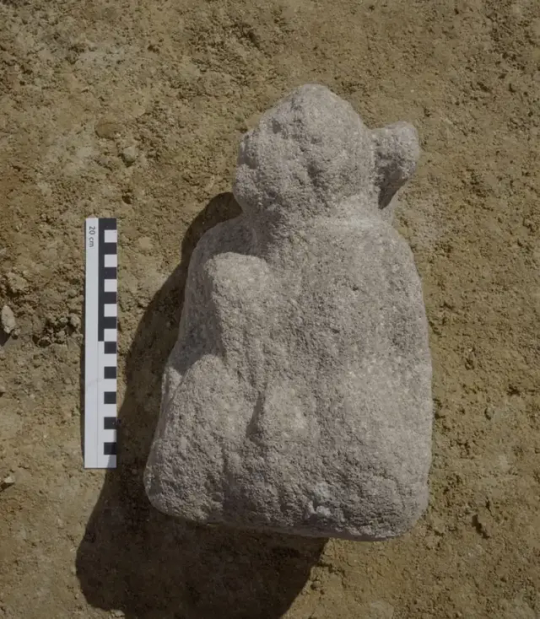
Jupiter columns “combine classical antiquity with probably Germanic beliefs,” Thiel explained. “Jupiter, throwing lightning bolts, rides on his horse over a figure crouching on the ground, usually naked and bearded, as can be seen, for example, in a group from Hausen an der Zaber in the Heilbronn district.” This specific example presented Jupiter as nature’s master, Thiel added.
“Every archaeologist is happy when a beautiful find is made,” he said. But, when the staff at the nearby Württemberg State Museum caught wind of the discovery, they remembered that most Jupiter columns included a Four Gods Stone at their base. “In the depot of the Württemberg State Museum there is a badly damaged Four Gods Stone with depictions of the Roman deities Mercury, Juno, Hercules and Minerva,” said the museum’s head of archaeology, Astrid Fendt. Mercury, Juno, and Minerva formed the Capitoline Triad of Gods. Although Juno wasn’t a fan of Hercules, the Hapsburg family did consider him a legitimate ancestor.
The museum’s Four Gods Stone surfaced in 1908 near a well on the edge of the same lot being excavated. “At the time, a large barracks was being built,” representatives for the city said. The find instigated a more exhaustive excavation. Thiel said that the figure they just found “could also have been lying there, but it probably escaped our colleagues at the time, which is not surprising.”
Crews will continue scouring the site for further artifacts through the end of May. “By then, the entire construction window will have been examined and all finds will have been recovered,” the city said. “We hope that it will soon be possible to show the little giant together with the relief of the gods in a special exhibition.”
By Vittoria Benzine.
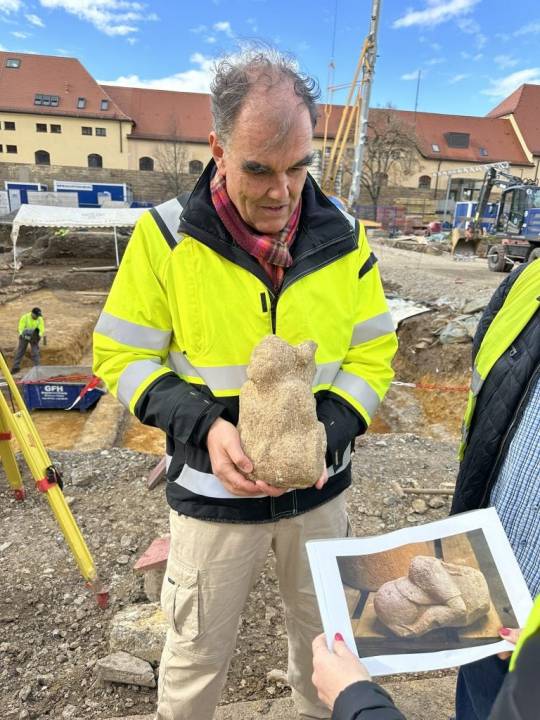
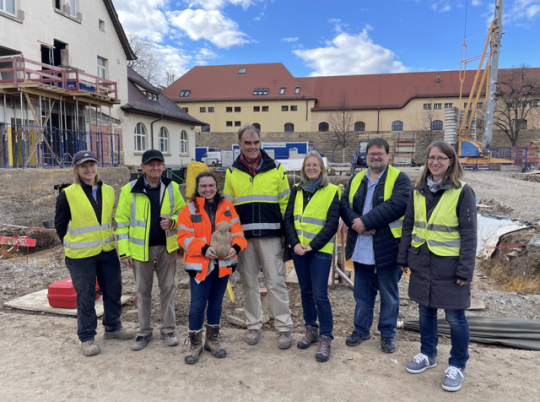
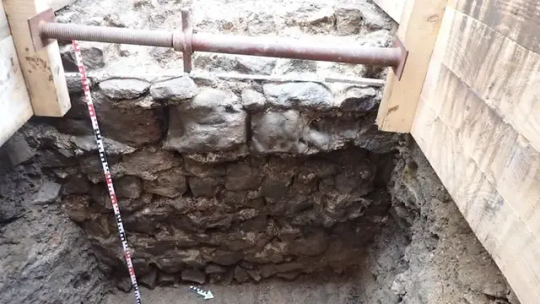
#Stone Sculpture of a Roman ‘Giant’ Unearthed at Ancient Fort in Germany#Stuttgart Germany#stone statue#ancient artifacts#archeology#archeolgst#history#history news#ancient history#ancient culture#ancient civilizations#roman history#roman empire#roman art
24 notes
·
View notes
Text
With the support of Eurojust and Europol, the Regional and District Prosecutor's Office in Dobrich together with the Main Directorate "Fighting Organized Crime", the police and the prosecutor's office of the city of Heilbronn, Germany, have taken action against an organized criminal group for human trafficking for the purpose of sexual exploitation, announced the Prosecutor's Office.
During a joint operation on 04/05/2023, 5 persons were detained and 8 searches were carried out.
In the summer of 2022, complaints were filed in Bulgaria by persons who suffered from human trafficking for the purpose of sexual exploitation. A pre-trial proceeding was established under the leadership of the District Prosecutor's Office-Dobrich. In line with international cooperation, contact was made with the German police and prosecutor's office.
The investigation of the criminal network in Germany began in 2022. Two organized criminal groups of Bulgarian citizens who were at enmity with each other were found. In the course of the investigation, data was collected on keeping persons in forced submission, causing bodily harm as a result of physical harassment, inducing prostitution and drug trafficking (cocaine). The suspects targeted and recruited vulnerable Bulgarian women who were transported to Germany and forced into prostitution.
After meetings held in Europol and Eurojust, the actions of the two countries to continue the investigation and uncover the criminal activity of the individuals were agreed upon. An agreement has been reached to send a European Investigation Order.
During the joint operation, five searches were carried out on the territory of Bulgaria and one suspect was detained. Three searches were conducted on the territory of Germany and 4 persons were detained. During the searches, various items and objects were found and seized, among them mobile phones, laptop computers, illegal poker machines, cold weapons, money and numerous gold ornaments. Identified victims of criminal activity have been offered protection and assistance.
9 notes
·
View notes
Conversation
The signs as Buildings and structures in Heilbronn (district):
Aries, Libra: Neckarsulm TDS Office Tower
Taurus, Scorpio: Klinikum am Weissenhof
Gemini, Sagittarius: Bad Rappenau station
Cancer, Capricorn: Stettenfels Castle
Leo, Aquarius: Bad Friedrichshall Hauptbahnhof
Virgo, Pisces: Horneck Castle, Germany
4 notes
·
View notes
Photo

haus h4 in #heilbronn . architects: joa. this building is part of a project that showcases the future of urban development and city planning. the new city district #neckarbogen is a crucial part of the #bugaheilbronn exhibitions. i didn't have a chance to have a closer look at all the buildings though, that part alone would mean a whole day of exploring and learning and the grounds of the garden show were huuuuuge. i pinned heilbronn to my 'must re-visit' part of brain, maybe when all of the buga shenanigans are over and done with in autumn/winter or next year. #architecture #cityplanning #urbandevelopment #squares (hier: BUGA Heilbronn 2019) https://www.instagram.com/p/ByuOB0_iHqb/?igshid=8x0p9dspcw1p
1 note
·
View note
Text
Küppersmühle Museum Duisburg Building, Germany
Küppersmühle Museum Building, MKM Duisburg Photos, Herzog & de Meuron Architecture Design
Küppersmühle Museum, Germany
MKM Duisburg: German Museum building design by Herzog & de Meuron Architects
Updated 23 Sep 2021 + 3 Feb 2010
Design: Herzog & de Meuron, Switzerland
Location: Duisburg, Germany
Photos © Simon Menges
Museum Küppersmühle Extension
A grain mill was erected in 1860 on the site of the present Museum Küppersmühle by industrialist Wilhelm Vedder, one of the founding fathers of Duisburg’s Inner Harbour. In 1900 the first mill using the most up-to-date technology went into operation in the Inner Harbour, which became known as the ‘bread basket of the Ruhr district’, and in 1908 the earlier buildings were replaced by the three-part structure now housing the museum.
The business was taken over in 1912 by the Werner & Nicola works, who added a boiler house with chimney. The adjoining steel silos were constructed in the 1930s. In 1969 the company merged with the Küppers works of Homberg, which gave its name to the mill and the museum. The mill closed down in 1972.
The Museum Küppersmühle (MKM), a project by Herzog & de Meuron dating from 1999, was the first milestone in the transformation of the Inner Harbour into an attractive focus of urban life. As a museum, the former mill, with its historic brick elevations, became the centre of a new, high-grade, multi-use inner-city location. Since 1999 the Küppersmühle has housed an art museum, run by the Stiftung für Kunst und Kultur e.V. (a registered cultural association in Bonn), that contains one of the finest collections of German art from the 1950s to the present.
The Ströher Collection The MKM Museum Küppersmühle presents key works and groups of works from the Ströher Collection, one of the most extensive private collections of German post-war art – to date on 2,500 sqm of exhibition space. With over 2,000 works, the collection comprises central positions of art development in Germany, from the immediate post-war period to the present. The focus is on painting, but the collection also includes sculpture and photography.
Over time, a desire for a building capable of housing all the works of art and displaying them in a manner worthy of a collection that includes many artists whose major significance is recognized internationally, among them Georg Baselitz, K. O. Götz, Jörg Immendorff, Anselm Kiefer, Sigmar Polke, Gerhard Richter, Fred Thieler and Rosemarie Trockel.
Extension project An extension to accommodate the collection was to be erected in 2008 on top of the silo towers. Faulty work by the steel-working company involved, and the company’s subsequent insolvency, meant that the steel-frame construction could not be installed. Construction work ceased and the project was abandoned owing to financing problems encountered by the client, the real estate company GEBAG. The building complex became the property of the Ströhers.
The extension project was activated in 2013, with the Ströher family as clients. A feasibility study undertaken by Herzog & de Meuron explored the potential of the site under current conditions. The resulting project constitutes a radical new start. The original idea of an illuminated cube balanced on the silo towers and visible from afar has been jettisoned. Instead, we propose to erect a building whose dimensions and materials accord with the sequence of historic brick structures lining the dockside. The new structure thus completes the existing museum complex in a visually appropriate way and forms a suitable conclusion to the row of buildings along the dock. At first glance it might seem as though the new building had always been there.
The new structure consists of three parts with a height of approximately 33.5, 30.5 and 27.5 metres respectively. In terms of mass, height and materials they take their cue from the existing buildings, continuing them and rounding them off to form a harmonious whole. Two parts contain the exhibition areas, the third provides access and houses utilities and art handling facilities. With five levels, one below ground, floor space amounts to some 4,900 square metres, in addition to exhibition areas of roughly 2,500 square metres.
Massing was crucially influenced by a ban on building within forty metres of the autobahn. Optimum use is made of the available area. The arrangement of the exhibition structures – the tallest of the three parts and the smaller one adjoining it – echoes the course of the building-free zone, while one elevation of the third part runs along its boundary. The additively composed parts remain distinctly legible. At its tallest point (the uppermost level of the larger exhibition component), the new structure is related in height to the main existing building.
The extension is to be linked directly to the existing exhibition spaces by bridges through the silos at the first and second upper levels, facilitating uninterrupted visitor access throughout the museum. Similarly, the height of the new exhibition areas takes its cue from the existing galleries. The silos will not only be converted into elements connecting the old with the new; they will also house distinctive exhibition spaces. Their original materials are to be retained, however, because the silos are an indispensable ‘sculptural’ component of the Küppersmühle as an industrial monument. Long reduced to this historical and aesthetic aspect, they acquire a new function through refurbishment as access links and display areas. Six inner silos had already been removed. Now, with the ground-floor ceiling opened up and the insertion of the bridges, the entire space will be visible to visitors. In addition, the silos can be seen from some of the exhibition areas.
As in the existing galleries, windows in the elevations facing the dock and Philosophenweg offer varied and striking views of the site and its surroundings. The material of the elevations echoes the brick of the existing buildings.
A staircase permits continuous visitor circulation and the arrangement of all the exhibits in a consecutive sequence. In conception and spatial context the staircase is related to that featured in the museum project of 1999.
The new exhibition areas echo the overall additive character of the Küppersmühle as a typical industrial facility of the nineteenth and twentieth centuries. In their architecture and interior design, the galleries echo the existing exhibition spaces. The uppermost display area, which is not directly accessible from the existing building, consists of a visible shed construction with top-lighting. All exhibition levels have a spatial arrangement facilitating flexible multiple use.
The silos are to be fitted out with a superstructure, as they were originally, in the 1930s. Featuring a viewing platform accessible from the dockside promenade, the superstructure will grant the silos yet another new function.
Project 2013-2021 Client: City of Duisburg
Photography © Simon Menges
Conversion of industrial building into museum for Grothe Collection
Partner in Charge: Pierre de Meuron
Innenhafen Duisburg Werhahmühle Küppersmühle, blaue stunde: photo : Tuxyso / Wikimedia Commons
The Küppersmühle – original building Date built: 1908-16 Design: Kiefer Brothers & Joseph Weiss
Brickwork building within Duisburg masterplan by Foster & Partners
Contact Details
Address: Philosophenweg 49 47051 Duisburg, Germany
Phone: 0203 301948-11
Küppersmühle Museum architects – Herzog & de Meuron
Based in a former warehouse, the MKM was opened in April 1999. The building was redesigned by the Swiss architects Herzog & de Meuron, using a masterplan devised by Norman Foster. After gutting the original industrial building an exhibition space of 3,600 m² was created across three storeys. With 6-meter high ceilings, grey Turkish basalt natural daylight is provided by the ceiling-high window slits. The building is served by an external staircase attached to the original building.
Location: Philosophenweg 49, 47051 Duisburg, Germany, western Europe
Architecture in Germany
German Architecture
German Architectural Designs – chronological list
German Building News
German Architect
Feuerstein Arena, Schierke, Harz district, Saxony-Anhalt Architects: GRAFT photo : Michael Moser Feuerstein Arena Schierke
James Simon Galerie, Berlin Design: David Chipperfield Architects photo © Ute Zscharnt for David Chipperfield Architects James Simon Galerie
Heilbronn — A City Redesigns Itself, Baden-Württemberg, South West Germany image © Sauerbruch Hutton BUGA Bundesgartenschau Heilbronn 2019 Buildings
New Train Station Development, Altona, Hamburg Design: C.F. Møller Architects image courtesy of architecture office New Train Station Development in Altona
Modern Architects
German Buildings
German museum building : Folkwang Museum, Essen
The Nebra Ark Design: Holzer Kobler Architekturen The Nebra Ark
Pritzker Prize Archietcts – Jacques Herzog & Pierre de Meuron : Winners in 2001
Comments / photos for the Küppersmühle Museum building design by Herzog & de Meuron Architects page welcome
Website: www.museum-kueppersmuehle.de
The post Küppersmühle Museum Duisburg Building, Germany appeared first on e-architect.
0 notes
Video
Lauffen am Neckar... par kanaristm Via Flickr : Lauffen am Neckar is a town in the district of Heilbronn, Baden-Württemberg, Germany. It is situated on the river Neckar, 9 kilometres southwest of Heilbronn. Pictured here along the Neckar River is the Regiswindiskirche,
1 note
·
View note
Video
Afternoon Sun enchanted Autumn Landscape by Uschi Via Flickr: The walk through the old town and the park constituted a magnificent afternoon. Autumn is so beautiful when the weather is fine and the coloured leaves are glowing in the sun like again last weekend. Here you see a colourful view from the bridge over the Enz. Bietigheim-Bissingen, Germany is the second-largest town in the district of Ludwigsburg, Baden-Württemberg. It is situated on the river Enz, about 19 km north of Stuttgart, and 20 km south of Heilbronn. The park is part of the horticultural show held in 1989. The garden for citizens is on the edge of Old Town. Please take your time … I love it to view Large On Black Der Spaziergang durch die Altstadt und den Bürgergarten ergaben einen herrlichen Nachmittag. Ich liebe den Herbst, wenn die Sonne scheint und die bunten Blätter zum Leuchten bringt. Diese Aufnahme habe ich von der Brücke über die Enz gemacht. Bietigheim-Bissingen ist die zweitgrößte Stadt im Landkreis Ludwigsburg, Baden-Württemberg, Deutschland. Bietigheim an der Enz gelegen, befindet sich ca. 19 km nördlich von Stuttgart, und 20 km südlich von Heilbronn. Der Park ist Teil der Landesgartenschau, die 1989 abgehalten wurde. Der Bürgergarten befindet sich am Rande der Altstadt. © 2011 Ursula Sander - All rights reserved.
3 notes
·
View notes
Text
Family dispute in Guglingen: Brother suspected of being killed | Heilbronn
Family dispute in Guglingen: Brother suspected of being killed | Heilbronn
[ad_1] After the violent death of a 15-year-old in a family dispute in Guglingen (Heilbronn district), the older brother is suspected of being a crime.
As the police announced on Monday, the seriously injured 17-year-old was still in the hospital, the preliminary arrest. According to investigations to date, he is strongly suspected of having killed his brother. Father is seen as a witness to the…
View On WordPress
0 notes
Link
At 5:30 in the morning, Joshua Miller has already been up an hour. Dressed in navy blue trousers, a purple plaid shirt, black leather shoes and a straw hat, Miller sits on the porch of The Family Place’s men’s shelter with his 2-year-old son, Jordan.
The nondescript house sits on a quiet street in Dallas. If you didn’t know it was there, you’d walk right past it.
It's currently the only men's shelter in Texas. For the men who come here, the day-in and day-out challenges are similar to those faced by many female victims of domestic violence. But these men face some unique hurdles, as well.
The men’s shelter opened after The Family Place got $150,000 in grants from the United Way, the Meadows Foundation and the Criminal Justice Division. Paige Fink, CEO of The Family Place, said the money allowed the organization to hire the staff for the shelter. Staff members said the Dallas men's shelter and the Taylor House for Men in Batesville, Ark., are the nation's only shelters specifically for men.
Last year, before the Dallas men’s shelter opened, The Family Place served 32 men and gave them hotel rooms. Fink thinks the new shelter will let The Family Place help at least 50 this year.
Miller, 36, has been at the shelter nearly four weeks with his son, but today is the first day he could get the child into a day care. Jordan sits anxiously in his father’s lap as birds begin to chirp around him. Jordan has been allowed to take one of his toy cars with him for the day and clutches it with all the strength his tiny hands can muster. Miller takes slow drags from a cigarette to pass the time.
The van for the day care finally rolls up; the father and son have been waiting about 20 minutes. Jordan wails as his father hands him off to the worker, and the doors slide shut. “I’ll see you later. Be good,” Miller says, struggling to hold in his emotions.
He knew it would be hard to let his son go off for the first time, but he has to get ready for the coming day. He’s got a day full of appointments to take care of and has to catch a bus by 7:30 a.m.
The shelter tries to get clients back on their feet within 45 days. It’s just Miller and his son in the small room they now call a home. But once Jordan is off to day care, Miller is on his own.
Without a home
Miller can’t be late for his bus. He waits at the stop for a ride taking him to DART's West Transfer Center. When he gets there, the sun in the sky is still gently nudging homeless people out of their slumber.
Seeing this is a sobering reminder for Josh of just how close he and his son came to ending up among their ranks. Even though he’s at a shelter, he’s still classified as homeless.
Miller never expected to be at a shelter for male victims of domestic violence. On June 6, Gekyma Robinson, Miller's ex-girlfriend and Jordan's mother, was arrested on suspicion of assaulting Miller, according to an arrest warrant. The affidavit for the warrant says a witness saw Robinson hit Miller with a child's guitar and with her hand after an argument about rent payment. Miller was granted an order for emergency protection for him and his son, according to records from the Dallas County district attorney's office provided by Miller.
When contacted by The News, Robinson said: "I'm sorry. I hate that it happened." She declined to comment further. Her next court date is set for later this month. She is not in jail.
The police gave Miller a list of places to seek for shelter after the assault. The Family Place was the first name that came up. Soon, Miller had a room and a safe place to stay. Two small bunks take up most of the space. Hanging on the wall is small TV that Miller uses to play Call of Duty on his Xbox in what little free time he has.
What the shelter doesn’t offer in luxurious accommodations, it makes up in security. Bells ring anytime someone walks into or out of the shelter. Cameras are everywhere.
Margie Heilbronner, a case manager for The Family Place, is in charge of day-to-day operations of the shelter. She’s been working with male victims for about 12 years, so the challenges they face are nothing new to her.
The U.S. Centers for Disease Control and Prevention says 27.5 percent of men are victims of violence by an intimate partner at some time in their lives.
Heilbronner says abuse of men is still not widely addressed for a number of reasons. There are the gender norms that portray men as always strong and unlikely be abused. She said there's also a lack of public awareness about men as victims of domestic violence.
She said pride is one thing that affects male victims differently than women. “Because if they talk to their best friend, they’re laughing," she said. "They’ll say, ‘Suck it up, you’re a man, you shouldn’t have to put up with that.’”
Even at the shelter, the stigma still exists. Miller said that one day another client came up to him and told him bluntly, “I would never let a woman hit on me.”
Securing resources
A large part of Miller’s day consists of getting in lines and waiting. He has an appointment at Greater Workforce Solutions, where he spends the better part of two hours sitting in a chair and listening for his number to be called. He’s been here enough times to know some of the workers by name, but mostly he sits quietly and patiently by himself.
For Miller, one of the hardest parts about getting everything set up has been securing resources for his son. Workers at The Family Place say getting social services to help male victims is a challenge.
Even at The Family Place, there are more services for women than men. The women’s shelter has on-site services such as day care and a nurse, but the men’s shelter does not.
Miller is Jordan’s custodial parent and receives government benefits that help pay for food and living expenses. But the process to receive aid is slow.
It took him the better part of three weeks to find day care for Jordan. Until he found a place for the boy, he had to take him on his trips across the city to hunt for jobs and apartments and sign up for government-sponsored programs.
Now that Jordan is taken care of during the day, Miller's commute is a little easier. But only by a bit. Riding around the city on the DART has been eye-opening for Miller, who uses a mix of trains and buses.
But it’s a grueling process. It takes him two hours to get to his appointment at the Southwest Workforce Center near Duncanville. Most of the trip is spent waiting at stops under the sweltering summer sun. If Miller had access to a car, the drive would take about 20 minutes.
Challenges growing up
Born and raised in Youngstown, Ohio, Miller faced challenges from an early age. Factories in the town had mostly shut down by the time he was born. With few opportunities, kids took to the streets to get by. Miller recalled kids as young as 12 being gang members. At 21, they were considered OGs, or original gangsters. If they made it that long.
Miller admits he’s done things he regrets. There’s a wound in his left leg from where a family member shot him during an argument a few years ago. He has a criminal record for a marijuana possession arrest in 2008. But now he’s seeking a new start.
Despite the limitations of public transportation, Miller says he’s done more in the last three weeks than in the last three years.
He says he can’t be bitter. He has a routine and he sticks to it to ward off chaos. He carries a white plastic binder of documents for him and Jordan at all times. His mornings start well before the crack of dawn. But he can’t risk putting him or his son anywhere near the streets.
Miller finishes out his day by getting fitted for a suit at the Southwest Workforce Center. With the help of a stylist provided by the center, he tries on several suits for job interviews before settling on one. After that, he has to catch a bus and rush to an appointment in South Dallas before he gets back to The Family Place shelter around 6 p.m.
Home
One evening, three weeks later, Jordan won’t stop crying. The toddler has just returned home from day care. But he doesn't react well when Miller uses a siphon to clear the child's sinuses. That’s when the tears start rolling.
After negotiating with the child for what seems forever, Miller finally gets him to calm down by giving him a bright yellow “Minions” plush doll. It’s been a long day for everyone. In fact, it’s been a long couple of days.
Over the weekend, Miller and Jordan got into an apartment provided and furnished by The Family Place. For now, it has only the bare necessities: a small gray couch in the living room, a dining room table for two, two mattresses in the bedroom, a refrigerator, a stove, a dresser and a couple of lamp stands. There’s not a TV.
The bare white walls are a testament to just how new this is for Miller and his son. Over the last three weeks, a lot has changed. Miller now has a job sorting clothes at a Goodwill warehouse. It doesn't pay much — $8.95 an hour — but he's just been offered a permanent position there.
The father and son are still considered homeless since they’re living in transitional housing. Miller still needs to find a home he can pay for on his own. The transitional housing program is applied in six-month increments and can last up to 18 months, but he wants to find permanent housing soon.
His biggest fear during this process was how everything would affect Jordan. His son has been his motivation throughout the process. “Parenting is not hard, but life is,” Miller says. “If you love your child, [responsibility] becomes a part of you.”
The situation has also taught him about the realities of domestic violence and why it’s so hard for victims to come forward. “A lot of times people are afraid to speak up because ... they’re still in love,” he says. “Maybe they have fears. Maybe it’s insecurity. Pride issues. Not knowing one’s self-worth.”
Jordan starts fussing for food, so Miller makes him a snack of vienna sausages, potato chips and Kool-Aid to hold him over until supper. He starts heating up the stove and begins to prepare a meal of chicken, rice, green beans and bread.
Miller will share the dinner with his son, who knows how to manipulate his heartstrings just a little bit. Life still isn’t “normal” for them, and it may never be. But for now, at least they’re together.
#dallas#texas#domestic violence#shelters#men#fathers#parents#homeless#victims#starting over#touching#struggles#men's rights#men's issues
4 notes
·
View notes
Text
ZNJ2
Great prices on Qantas B787-9 VH-ZNJ "Qantas 100" Livery (1:400) by GeminiJets 400 Diecast Airliners. Die Cast and Collectible Models for sale at Diecast ... Book a hotel near or at Heilbronn Airport in Heilbronn for the ultimate convenience and comfort. Travel the world better with Expedia & earn savings by ... Vessel Details. Vessel Code: ZNJ. Lloyd's NO: 9261451. Call Sign: A8UY9. Built in: 2002. Flag: Liberia. Voyage Details. Zim Voyage No: 35. Partner's Voyage ... Z.N.J. LIMITED - Free company information from Companies House including registered office address, filing history, accounts, annual return, officers, charges, ... Welcome to ZNJ Communications Group, LLC, the leading electrician and low voltage specialist, serving Las Cruces and the surrounding areas! With over 14 ... In the Interest of Z.N.J., a Child Appeal from 223rd District Court of Gray County.
0 notes
Text

willkommen-in-germany:Somewhere in Franken. The term Franken...
Somewhere in Franken. The term Franken (Franconia) is used to refer to the eastern part of the historic Duchy of Franconia, mainly represented by the Bavarian districts of Unterfranken (capital: Würzburg), Mittelfranken (capital: Ansbach), and Oberfranken (capital: Bayreuth). Due to respective local East Franconian dialects, parts of the Heilbronn region in Baden-Württemberg, parts of Thüringen, and a small part of Hessen (Gersfeld) are also considered Franconian regions - its 2 largest cities are Nürnberg and Würzburg.
0 notes
Text
Office Administrator At The Glamira Sydney Central Business District
Office Administrator At The Glamira Sydney Central Business District
Who we are GLAMIRA.com is the online shop for all jewellery lovers. Founded in Heilbronn, Germany in 1999, GLAMIRA has gradually become one of the leaders in online sales of high quality wedding and engagement jewelry. In 2012, GLAMIRA began to design its own products. At the same time, GLAMIRA began to develop its e-commerce infrastructure, patented designs and the process of online sales were…
View On WordPress
0 notes
Video
youtube
Interesting Rottweiler Facts Dogs 101 #dog #Rottweiler Website: http://ift.tt/2hJcgmZ Good Dog, Carl - http://amzn.to/2lwvMFq Carl's Birthday - http://amzn.to/2l1bAJB Carl's Afternoon in the Park - http://amzn.to/2mdrB0P Social Media Links: Facebook: http://bit.ly/2j3sKbX Twitter: http://bit.ly/2kbln45 Instagram: http://ift.tt/2jMTwGl Google+: http://bit.ly/2jHJLcp Patreon: http://bit.ly/2jh2A2Y From wikipedia: The Rottweiler (UK /ˈrɒtvaɪlə/ or /ˈrɒtwaɪlə/) or (US /rɒtwaɪlər/)[1][2] is a breed of domestic dog, regarded as medium-to-large[3][4] or large.[5][6]The dogs were known in German as Rottweiler Metzgerhund, meaning Rottweil butchers' dogs, because one of their uses was to herd livestock and pull carts laden with butchered meat to market.[3] This continued until the mid-19th century when railways caused droving to be replaced with herding. Rottweilers are now used as search and rescue dogs, as guide dogs for the blind, as guard dogs and police dogs.[7] The Rottweiler is one of the oldest of herding breeds.[8] With a history possibly dating back to the Roman Empire,[9] the Rottweiler may be a descendant of ancient Roman drover dogs; a mastiff-type dog that was a dependable, rugged dog with great intelligence and guarding instincts. During their quest to conquer Europe, the Roman legions traveled in large numbers across the continent. The non-existence of refrigeration meant the soldiers had to bring herds of cattle for food. The drover dogs were used to keep the herds of cattle together and to guard the herds at night. Around A.D. 74 the Roman army travelled across the Alps and into what is now southern Germany. For the next two centuries the Roman drover dogs were continually used in herding and driving cattle for trade even after the Romans were driven out of the area by the Swabians.[10] A town in this region was eventually given the name Rottweil.[10] It became an important trade center and the descendants of the Roman cattle dogs proved their worth by driving the cattle to market and protecting the cattle from robbers and wild animals.[10] The dogs are said to have been used by traveling butchers at markets during the Middle Ages to guard money pouches tied around their necks.[11] The dogs eventually came to be called Rottweiler Metzgerhunds, or butcher dogs.[10] As railroads became the primary method for moving stock to market, the need for the breed declined, as did the number of Rottweilers. The number of Rottweilers diminished so severely that by 1882 in a dog show in Heilbronn, there was only one very poor representative of the breed.[10] The buildup to World War I saw a great demand for police dogs, and that led to a revival of interest in the Rottweiler. During the First and Second World Wars, Rottweilers were put into service in various roles, including as messenger, ambulance, draught, and guard dogs. The Deutscher Rottweiler-Klub (DRK, German Rottweiler Club), the first Rottweiler club in Germany, was founded on 13 January 1914, and followed by the creation of the Süddeutscher Rottweiler-Klub (SDRK, South German Rottweiler Club) on 27 April 1915 and eventually became the IRK (International Rottweiler Club). The DRK counted around 500 Rottweilers, and the SDRK 3000 Rottweilers. The goals of the two clubs were different. The DRK aimed to produce working dogs and did not emphasise the morphology of the Rottweiler. The various German Rottweiler Clubs amalgamated to form the Allgemeiner Deutscher Rottweiler Klub (ADRK, General German Rottweiler Club) in 1921. This was officially recorded in the register of clubs and associations at the district court of Stuttgart on 27 January 1924.[12] The ADRK is recognised worldwide as the home club of the Rottweiler. In 1931 the Rottweiler was officially recognised by the American Kennel Club.[13] In 1936, Rottweilers were exhibited in Britain at Crufts. In 1966, a separate register was opened for the breed. In fact, in the mid-1990s, the popularity of the Rottweiler reached an all-time high with it being the most registered dog by the American Kennel Club.[14] In 2013, the American Kennel Club ranked the Rottweiler as the 9th most popular purebreed in the United States.[15] The portrayal of Rottweilers as vicious or malevolently aggressive dogs in several fictional films and TV series, most notably in The Omen, along with sensationalist press coverage, has created a negative image of the breed.[citation needed] However, some films and television shows, such as Lethal Weapon 3, the 1998 film Half Baked, and the hit HBO show Entourage, have portrayed Rottweilers in a positive light. They are also featured in the children's book series Good Dog, Carl by Alexandra Day. by Animal Facts
0 notes
Video
youtube
Interesting Rottweiler Facts Dogs 101 #dog #Rottweiler Website: http://ift.tt/2hJcgmZ Good Dog, Carl - http://amzn.to/2lwvMFq Carl's Birthday - http://amzn.to/2l1bAJB Carl's Afternoon in the Park - http://amzn.to/2mdrB0P Social Media Links: Facebook: http://bit.ly/2j3sKbX Twitter: http://bit.ly/2kbln45 Instagram: http://ift.tt/2jMTwGl Google+: http://bit.ly/2jHJLcp Patreon: http://bit.ly/2jh2A2Y From wikipedia: The Rottweiler (UK /ˈrɒtvaɪlə/ or /ˈrɒtwaɪlə/) or (US /rɒtwaɪlər/)[1][2] is a breed of domestic dog, regarded as medium-to-large[3][4] or large.[5][6]The dogs were known in German as Rottweiler Metzgerhund, meaning Rottweil butchers' dogs, because one of their uses was to herd livestock and pull carts laden with butchered meat to market.[3] This continued until the mid-19th century when railways caused droving to be replaced with herding. Rottweilers are now used as search and rescue dogs, as guide dogs for the blind, as guard dogs and police dogs.[7] The Rottweiler is one of the oldest of herding breeds.[8] With a history possibly dating back to the Roman Empire,[9] the Rottweiler may be a descendant of ancient Roman drover dogs; a mastiff-type dog that was a dependable, rugged dog with great intelligence and guarding instincts. During their quest to conquer Europe, the Roman legions traveled in large numbers across the continent. The non-existence of refrigeration meant the soldiers had to bring herds of cattle for food. The drover dogs were used to keep the herds of cattle together and to guard the herds at night. Around A.D. 74 the Roman army travelled across the Alps and into what is now southern Germany. For the next two centuries the Roman drover dogs were continually used in herding and driving cattle for trade even after the Romans were driven out of the area by the Swabians.[10] A town in this region was eventually given the name Rottweil.[10] It became an important trade center and the descendants of the Roman cattle dogs proved their worth by driving the cattle to market and protecting the cattle from robbers and wild animals.[10] The dogs are said to have been used by traveling butchers at markets during the Middle Ages to guard money pouches tied around their necks.[11] The dogs eventually came to be called Rottweiler Metzgerhunds, or butcher dogs.[10] As railroads became the primary method for moving stock to market, the need for the breed declined, as did the number of Rottweilers. The number of Rottweilers diminished so severely that by 1882 in a dog show in Heilbronn, there was only one very poor representative of the breed.[10] The buildup to World War I saw a great demand for police dogs, and that led to a revival of interest in the Rottweiler. During the First and Second World Wars, Rottweilers were put into service in various roles, including as messenger, ambulance, draught, and guard dogs. The Deutscher Rottweiler-Klub (DRK, German Rottweiler Club), the first Rottweiler club in Germany, was founded on 13 January 1914, and followed by the creation of the Süddeutscher Rottweiler-Klub (SDRK, South German Rottweiler Club) on 27 April 1915 and eventually became the IRK (International Rottweiler Club). The DRK counted around 500 Rottweilers, and the SDRK 3000 Rottweilers. The goals of the two clubs were different. The DRK aimed to produce working dogs and did not emphasise the morphology of the Rottweiler. The various German Rottweiler Clubs amalgamated to form the Allgemeiner Deutscher Rottweiler Klub (ADRK, General German Rottweiler Club) in 1921. This was officially recorded in the register of clubs and associations at the district court of Stuttgart on 27 January 1924.[12] The ADRK is recognised worldwide as the home club of the Rottweiler. In 1931 the Rottweiler was officially recognised by the American Kennel Club.[13] In 1936, Rottweilers were exhibited in Britain at Crufts. In 1966, a separate register was opened for the breed. In fact, in the mid-1990s, the popularity of the Rottweiler reached an all-time high with it being the most registered dog by the American Kennel Club.[14] In 2013, the American Kennel Club ranked the Rottweiler as the 9th most popular purebreed in the United States.[15] The portrayal of Rottweilers as vicious or malevolently aggressive dogs in several fictional films and TV series, most notably in The Omen, along with sensationalist press coverage, has created a negative image of the breed.[citation needed] However, some films and television shows, such as Lethal Weapon 3, the 1998 film Half Baked, and the hit HBO show Entourage, have portrayed Rottweilers in a positive light. They are also featured in the children's book series Good Dog, Carl by Alexandra Day. by Animal Facts
0 notes
